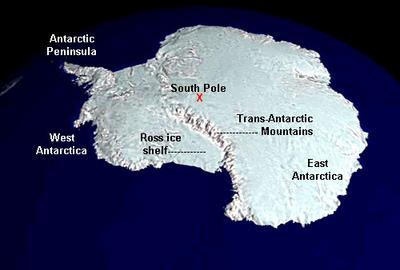5 November, 2004
What part of Antarctica are you in?
I live on a research station in called McMurdo Station located on Ross Island. It is located south of New Zealand.
I think of Antarctica as being divided into four geographic regions:
1. West Antarctica is where Ross Island is located. West Antarctica has land that is covered by an ice sheet that is more than one mile thick! Scientists say that if all the ice melted here, it would raise the world's sea level about 5 meters (over 16 feet)!
West Antarctica also includes a huge ice shelf. An ice shelf is a glacier that forms on land and then "slides" into the ocean. Imagine a frozen river, that is what a glacier is. Glaciers move very slowly across the land. When a glacier reaches the ocean it will either break up into icebergs or extend into the sea and float. If it floats and remains connected to the glacier on land, the floating part is called an ice shelf. If you want to see pictures of the Ross Ice Shelf where I work, click on: <http://www.vims.edu/bio/microbial/NBPishelf.html>. Ross Ice Shelf is about the size of France!
2. The Antarctic Peninsula is actually an extension of West Antarctica. It is south of South America, and it usually has the warmest temperatures in Antarctica. Unlike the rest of Antarctica where precipitation always falls in the form of snow, it can actually rain there in the summer!
3. East Antarctica is where the South Pole is located. It also includes land covered by an ever bigger ice sheet. In fact, it is the largest and thickest ice sheet in the world. Scientists say that if the massive East Antarctic Ice Sheet melted, it would raise the sea level 55 meters (over 180 feet)! East Antarctica also has ice shelves. East Antarctica is where the South Pole is located.
4. The Transantarctic Mountains separate East and West Antarctica. This is a chain of very rugged mountains.
You can see blue areas that represent the major ice shelves in Antarctica on the logo for the United States Antarctic Program. There are others, but they are much smaller than the ones on the logo.

Regions of Antarctica

United States Antarctic Program logo
Contact the TEA in the field at
.
If you cannot connect through your browser, copy the
TEA's e-mail address in the "To:" line of
your favorite e-mail package.
|
